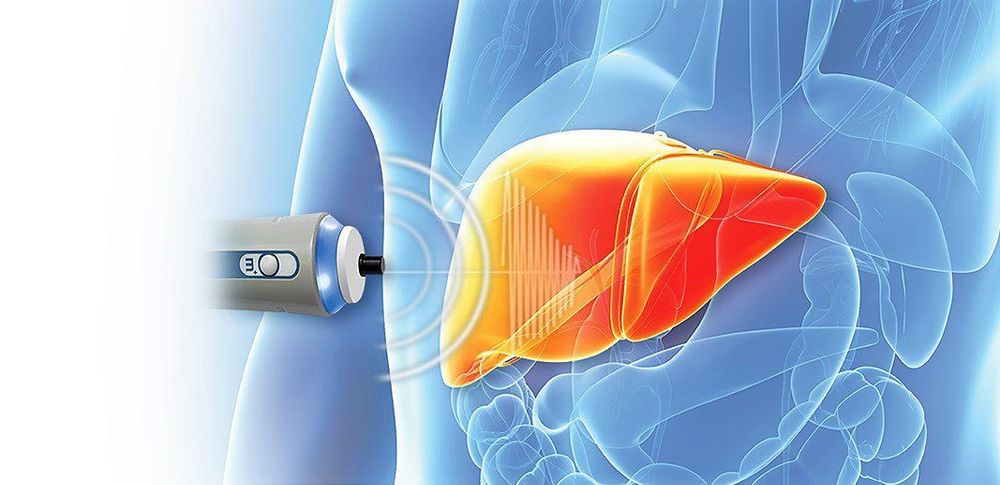This is an automatically translated article.
The article was professionally consulted by Specialist Doctor I Le Nguyen Hong Tram - Gastroenterologist - Department of Medical Examination & Internal Medicine - Vinmec Nha Trang International General Hospital.Evaluation of liver fibrosis by modern elastographic technique of liver tissue is gradually being widely used, giving patients the opportunity to screen for cirrhosis earlier and have timely treatment, improve treatment efficiency. treat.
1. What is the FibroScan technique?
FibroScan is a new ultrasound method, used to evaluate the degree of cirrhosis and fatty liver of the liver. The degree of liver fibrosis was assessed quantitatively by measuring the stiffness of the liver. By calculating from the ultrasound signal in the durometer, based on a controlled hypoechoic parameter, FibroScan is able to assess the fattyness of the liver.Patients with cirrhosis or fatty liver can be easily detected through FibroScan elastography, so that patients have the opportunity to be screened for cirrhosis earlier.

2. What is elastography of liver tissue?
2.1 Advantages and disadvantages of ultrasound elastography of liver tissue Ultrasound elastography of liver tissue is an ultrasound technique that evaluates the stiffness of liver tissue through the degree of elasticity of the tissue when subjected to mechanical force. Pathological tissues can have the same negative feedback, but they have different stiffness, the more malignant the tissue, the more stiffness increases. Therefore, assessing the stiffness of the damaged tissue will provide more information about the nature of that tissue.Liver elastography in evaluating the degree of liver fibrosis is also known as transient elastography. This is a technique used to assess the stiffness of the liver parenchyma, measured in units of kPa (kilopascals).
Elastography of liver tissue is a non-invasive diagnostic method with high accuracy equivalent to a liver biopsy, done quickly, without pain or any discomfort for the patient and cost. cheap, overcome the shortcomings of biopsies in determining liver fibrosis.
Advantages and disadvantages of elastography of liver tissue:
Advantages: Does not depend on the person doing the ultrasound. The sonographer only places the transducer in contact with the patient's skin without pressing. When performing the technique, the sonographer will press the ultrasonic generator button 10 times, the machine will record the horizontal vibration waves of those 10 times and calculate the average value. In particular, this is a non-invasive technique, which can help accurately assess the degree of cirrhosis in order to reduce the need for biopsies. Disadvantages: The pressure of the transducer is difficult to determine, so between this time and another time at the same person, between this person and another person, the impact force will be different, making the results inconsistent.

The principle of ultrasound elastography is that the tissue will deform when it is pressed. Tissue or lesion responds in several ways, depending on the mechanical makeup. Normal tissue will deform more with pressure, while harder diseased tissue will deform less. Tissue contrast on the elastography is due to tissue stiffness differences, color coded depending on the manufacturer.
The method of ultrasound elastography by applying an external force on the lesion to cause deformation of the lesion as above is called semi-static elastography, also known as deformed elastography. When performing the technique, the sonographer presses the transducer with a certain force to act on the damaged tissue.
2.3 Stage of liver fibrosis
Stage 0: No cirrhosis and no liver damage Stage 1: Begins to have liver damage, lesions with some fibrosis around the portal space around scattered blood vessels, no anastomosis together. Stage 2: Moderate liver damage, fibrosis around the portal blood vessels and not yet connected. Stage 3: Severe liver fibrosis, diffuse fibrosis, areas of fibrosis joined together. Stage 4: End stage liver damage, liver damage is severe and no longer functional. Evaluation of liver fibrosis by modern elastography technique of liver tissue is a non-invasive, high-precision diagnostic method equivalent to liver biopsy, which is performed quickly, without pain or any other symptoms. no discomfort for the patient and low cost. This method is a turning point of the ultrasound industry, overcoming the shortcomings of liver biopsy, and is gradually being used widely, giving patients the opportunity to screen for cirrhosis earlier.
Please dial HOTLINE for more information or register for an appointment HERE. Download MyVinmec app to make appointments faster and to manage your bookings easily.














